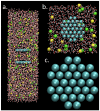Role of spatial ionic distribution on the energetics of hydrophobic assembly and properties of the water/hydrophobe interface
- PMID: 22231014
- PMCID: PMC4211274
- DOI: 10.1039/c1cp20839j
Role of spatial ionic distribution on the energetics of hydrophobic assembly and properties of the water/hydrophobe interface
Abstract
We present results from all-atom molecular dynamics simulations of large-scale hydrophobic plates solvated in NaCl and NaI salt solutions. As observed in studies of ions at the air-water interface, the density of iodide near the water-plate interface is significantly enhanced relative to chloride and in the bulk. This allows for the partial hydration of iodide while chloride remains more fully hydrated. In 1 M solutions, iodide directly pushes the hydrophobes together (contributing -2.51 kcal mol(-1)) to the PMF. Chloride, however, strengthens the water-induced contribution to the PMF by ~-2.84 kcal mol(-1). These observations are enhanced in 3 M solutions, consistent with the increased ion density in the vicinity of the hydrophobes. The different salt solutions influence changes in the critical hydrophobe separation distance and characteristic wetting/dewetting transitions. These differences are largely influenced by the ion-specific expulsion of iodide from bulk water. Results of this study are of general interest to the study of ions at interfaces and may lend insight to the mechanisms underlying the Hofmeister series.
Figures















Similar articles
-
Free energetics of carbon nanotube association in aqueous inorganic NaI salt solutions: Temperature effects using all-atom molecular dynamics simulations.J Comput Chem. 2015 Jun 15;36(16):1196-212. doi: 10.1002/jcc.23906. Epub 2015 Apr 13. J Comput Chem. 2015. PMID: 25868455 Free PMC article.
-
Ion specific protein assembly and hydrophobic surface forces.Phys Rev Lett. 2008 Jun 27;100(25):258105. doi: 10.1103/PhysRevLett.100.258105. Epub 2008 Jun 26. Phys Rev Lett. 2008. PMID: 18643709
-
Electrostatic properties of aqueous salt solution interfaces: a comparison of polarizable and nonpolarizable ion models.J Phys Chem B. 2008 Sep 18;112(37):11679-93. doi: 10.1021/jp8038835. Epub 2008 Aug 20. J Phys Chem B. 2008. PMID: 18712908 Free PMC article.
-
Ions at hydrophobic interfaces.J Phys Condens Matter. 2014 May 21;26(20):203101. doi: 10.1088/0953-8984/26/20/203101. Epub 2014 Apr 25. J Phys Condens Matter. 2014. PMID: 24769502 Review.
-
Recent developments in the theoretical, simulational, and experimental studies of the role of water hydrogen bonding in hydrophobic phenomena.Adv Colloid Interface Sci. 2016 Sep;235:23-45. doi: 10.1016/j.cis.2016.05.006. Epub 2016 May 18. Adv Colloid Interface Sci. 2016. PMID: 27312562 Review.
Cited by
-
Temperature dependence and energetics of single ions at the aqueous liquid-vapor interface.J Phys Chem B. 2013 May 30;117(21):6512-23. doi: 10.1021/jp401243m. Epub 2013 May 17. J Phys Chem B. 2013. PMID: 23537166 Free PMC article.
-
Free energetics of carbon nanotube association in aqueous inorganic NaI salt solutions: Temperature effects using all-atom molecular dynamics simulations.J Comput Chem. 2015 Jun 15;36(16):1196-212. doi: 10.1002/jcc.23906. Epub 2015 Apr 13. J Comput Chem. 2015. PMID: 25868455 Free PMC article.
-
Electrostatic contribution from solvent in modulating single-walled carbon nanotube association.J Chem Phys. 2014 Sep 21;141(11):114906. doi: 10.1063/1.4892566. J Chem Phys. 2014. PMID: 25240371 Free PMC article.
-
Free energetics of carbon nanotube association in pure and aqueous ionic solutions.J Phys Chem B. 2012 Jul 19;116(28):8154-68. doi: 10.1021/jp3025717. Epub 2012 Jul 10. J Phys Chem B. 2012. PMID: 22780909 Free PMC article.
-
Spherical monovalent ions at aqueous liquid-vapor interfaces: interfacial stability and induced interface fluctuations.J Phys Chem B. 2013 Oct 3;117(39):11732-42. doi: 10.1021/jp406001b. Epub 2013 Sep 16. J Phys Chem B. 2013. PMID: 24032752 Free PMC article.
References
-
- Frolov AI, Rozhin AG, Fedorov MV. Chem. Phys. Chem. 2010;11:2612–2616. - PubMed
-
- Lin S, Blankschtein D. J. Phys. Chem. B. 2010;2010:15616–15625. - PubMed
-
- Zelada-Guillen GA, Riu J, Duzgun A, Rius FX. Angew. Chem. Int. Ed. 2009;48:7334–7337. - PubMed
-
- Zelada-Guillen GA, Riu J, Duzgun A, Rius FX. Angew. Chem. 2009;121:7470–7473. - PubMed
Publication types
MeSH terms
Substances
Grants and funding
LinkOut - more resources
Full Text Sources
Research Materials

